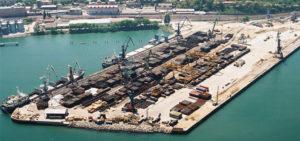
The Russian Government has accepted The Strategy of the development of the Caspian Sea ports until year 2030, informs PortNews agency. The Strategy involves the development of the Russian Caspian transport hub and its integration in the world trade, with Iran, India and the Gulf countries in particular.
Today, the Caspian ports – Astrakhan, Olya, Makhachkala – make up for only 0.5% of the total Russian ports throughput. In 10 months 2017 these facilities handled 3.2 mln tons (-35.5% as compared to 2016 y-o-y), which make their current utilization at around 25%. The container traffic is scarce: 1,665 TEU in January-September 2017, which is 0.05% of the total Russian container volumes (3.4 mln TEU). The port of Makhachkala handles primarily crude oil (87%), whereas Astrakhan and Olya mostly serve grain exports to Iran (80%). Until recently, the latter two were also heavily involved in exporting metals, however Iran’s strong development of its own metallurgical industry during the last 5 years has led to decreasing this type of cargo almost to zero.
Still, the ports are believed to have a strategic location at the northwest of the Caspian Sea for Russia-Iran trade, which is expected to liven up following the lifting of economic sanctions on Iran in 2016. According to the Strategy, the ports may also become part of the North-South transport corridor 7,200 km long from St. Petersburg to Mumbai, India, as well as of the Chinese One-Belt-One-Road initiative.
The Strategy outlines the modernization of the existing ports and construction of 2 new terminals (cargo and passenger) at the territory of the Dagestan republic, as well as the development of road and rail links to these ports. The preliminary site for the new deep-water cargo terminal has been defined at the area of Kaspiysk town, 20km southbound of Makhachkala. The new port will be handling containers and grain. For grain handling, there is to be constructed a dedicated grain terminal of 2 mln tons capacity by 2025, which is to be increased to 3 mln tons by 2030.
The Strategy sets the following milestones:
2018-2019 – developing the legal base, including a Federal law introducing Free Port regime in the Caspian region; establishing a logistic operator for development of the trade routes from Russia to India and the Gulf countries via the Caspian Sea and Iran.
2020-2025 – designing the new deep-water port; Phase 1 construction and commissioning.
2026-2030 – the new deep-water port Phase 2 construction.
According to the Strategy, the development of the Caspian ports will allow to increase their container flows up to 265,000 TEU, grain exports up to 7 mln tons and other dry bulk cargoes up to 7 mln tons per year.
